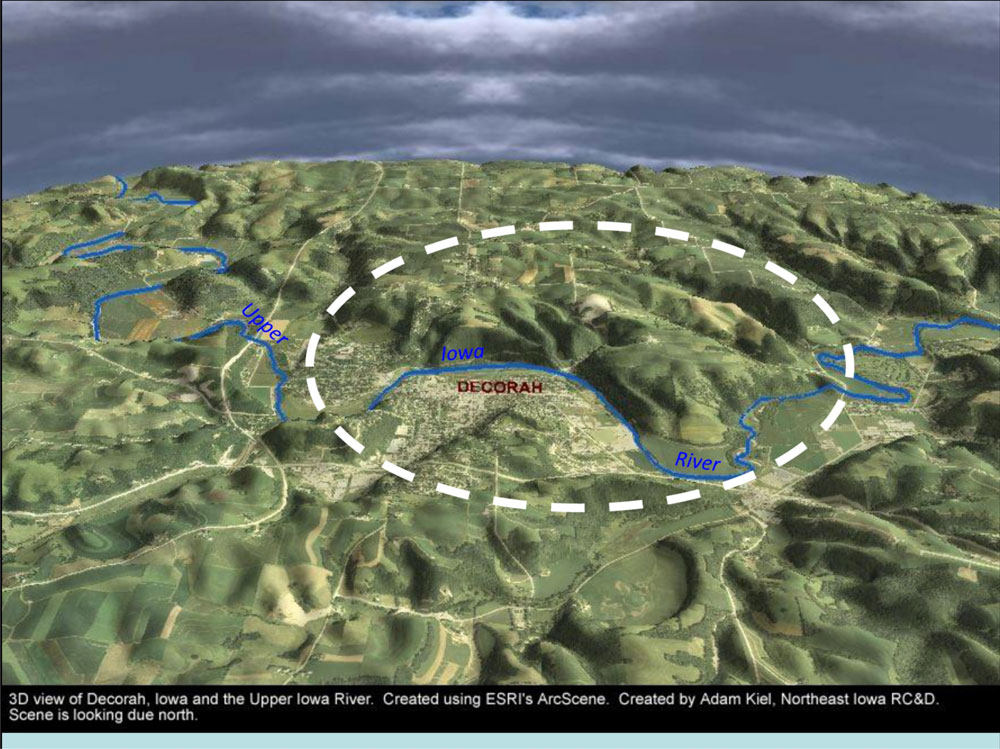Meteorite Crater Under Iowa Confirmed in New Images

Buried beneath the rocks, dirt, buildings and roads of the city of Decorah, Iowa, lies a 470 million-year-old meteorite crater.
Unlike the craters on the pockmarked surfaces of the moon and Mars, this crater can't be seen by looking down at Earth's surface, at least not by the human eye.
But recent aerial surveys primarily aimed at getting a better picture of the minerals that underlie the region got a look at the crater structure using instruments that detect the variations in gravity of different types of rock, as well as their ability to conduct electricity.
"Capturing images of an ancient meteorite impact was a huge bonus," Paul Bedrosian, a U.S. Geological Survey geophysicist in Denver who is leading the effort to model the data the surveys acquired, said in a statement.
The images provided corroborating evidence that the feature is in fact an impact crater. They are the "first images which really show the geometry," Bedrosian told OurAmazingPlanet.
Discovering a crater
The crater, known as the Decorah Impact Structure, was discovered during a 2008-2009 effort by scientists with the Iowa Geological and Water Survey to examine samples from drill cores (cylinders of sediment drilled out from the ground). In them, they found a unique unit of shale beneath and near Decorah.
Get the Space.com Newsletter
Breaking space news, the latest updates on rocket launches, skywatching events and more!
The shale formed a "nice circular basin" about 3.4 miles (5.5 kilometers) wide, Robert McKay, a geologist at the Iowa Geological Survey, said in the USGS statement. That makes the Decorah crater about four to five times the size of Arizona's famed Meteor Crater, Bedrosian said. [Meteor Crater: Experience an Ancient Impact]
The thinking is that the shale was deposited by an ancient seaway that formed some time after the impact that created the crater. The identity of the basin as an impact site wasn't known for certain, and more evidence was needed to back up the hypothesis.
Some of that added evidence came from the identification of shocked quartz in a layer of breccia below the shale. Breccia is a type of rock made up of broken fragments of other rocks cemented together by a finer-grained medium. The shocked quartz found within this breccia is considered strong evidence of a meteorite impact, Bedrosian said.

Shale signature
When the recent surveys set out, they were aware that the crater was in the area, he said. "We weren't aware that we would be able to image it so cleanly," Bedrosian told OurAmazingPlanet.
The keys to the sharp imaging were the distinctive electric conductivity and gravity signals of the shale layer.
"The shale is an ideal target and provides the electrical contrast that allows us to clearly image the geometry and internal structure of the crater," Bedrosian said in the release.
In the new view obtained from the surveys, the impact crater appears as a circular structure that is distinct from the area around it. This imaging provides still further evidence that the structure is indeed a crater.
The researchers plan to use the data they've taken to learn more about the crater and the meteorite that created it. The nearly circular shape of the crater suggests that whatever space rock caused the impact came from directly overhead, and the width of the crater suggests that the rock was a couple hundred meters across, Bedrosian said. The modeling he and his team are doing could tell them more about the energy the impactor had as it hit.
The team is planning to publish findings from the survey in the next six months, Bedrosian said, which will be the "ultimate scientific confirmation" of the crater. The crater will truly become official when it is added to the Earth Impact Database, he added. The database is a list that contains fewer than 200 confirmed meteor impacts (though many more meteors have impacted the Earth throughout its history, their signatures have simply been wiped away by the planet's active plate tectonics).
"Hopefully … we'll be adding one to the list," Bedrosian said.
This story was provided by OurAmazingPlanet, a sister site to SPACE.com. Follow Andrea Thompson @AndreaTOAP, Pinterest and Google+. Follow OurAmazingPlanet @OAPlanet, Facebook and Google+.
Join our Space Forums to keep talking space on the latest missions, night sky and more! And if you have a news tip, correction or comment, let us know at: community@space.com.

Andrea Thompson is an associate editor at Scientific American, where she covers sustainability, energy and the environment. Prior to that, she was a senior writer covering climate science at Climate Central and a reporter and editor at Live Science, where she primarily covered Earth science and the environment. She holds a graduate degree in science health and environmental reporting from New York University, as well as a bachelor of science and and masters of science in atmospheric chemistry from the Georgia Institute of Technology.










